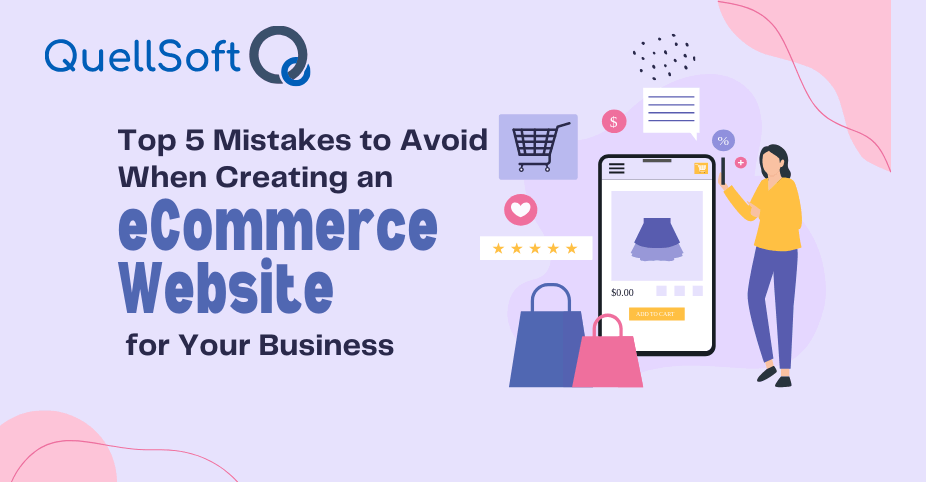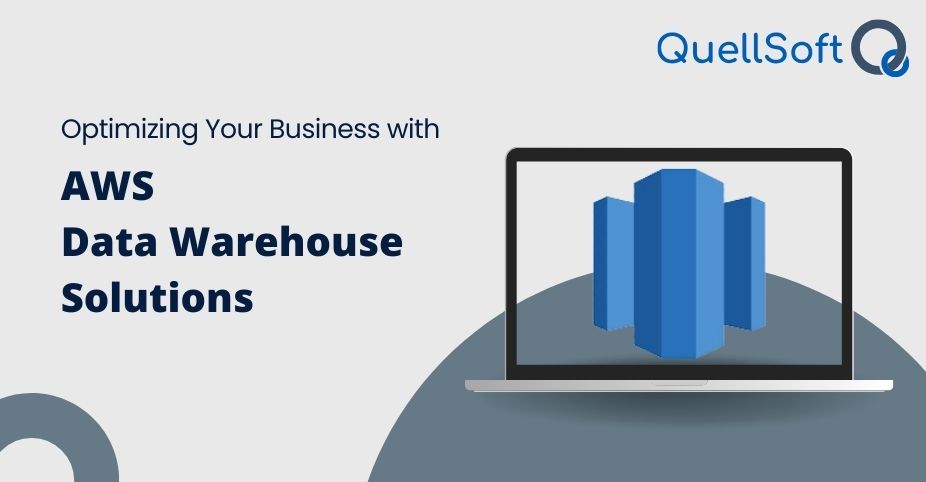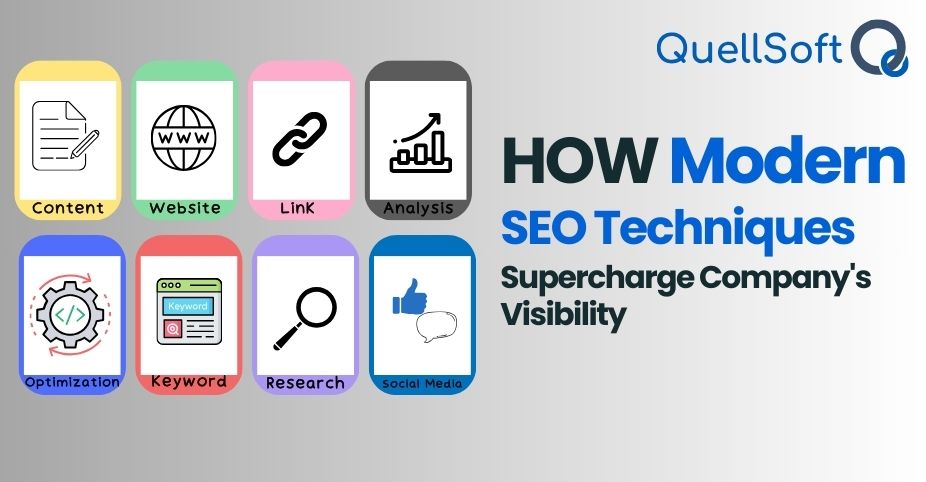
Top 5 Mistakes to Avoid When Creating an eCommerce Website for Your Business
In today’s fast-paced digital world, having a strong online presence is crucial for any business. For those in competitive markets like New York and New Jersey, creating an eCommerce website is no longer a luxury—it’s a necessity. However, just launching a website isn’t enough to guarantee success.
Businesses often make critical mistakes during eCommerce website development that hinder their growth and cost them valuable customers. Whether it’s poor user experience, ineffective SEO strategies, or weak mobile optimization, these missteps can be detrimental to your business.
Creating an eCommerce Website to boost web traffic & Sells
In this guide, we’ll delve into the top five mistakes to avoid when creating an eCommerce website for your business. By steering clear of these common errors, you’ll be well on your way to building a site that not only attracts more customers but also drives sales—powered by Quellsoft expertise.
Ignoring User Experience (UX) Design
Why UX Design is Critical in eCommerce Web Development
When creating an eCommerce website, one of the biggest mistakes businesses make is neglecting user experience (UX). UX design is all about making sure your website is intuitive, easy to navigate, and enjoyable for users. If visitors can’t find what they’re looking for quickly, they’re likely to leave—and never return.
A cluttered, confusing site with slow load times and poor navigation is a recipe for disaster. Not only will it frustrate potential customers, but it will also increase your bounce rate, ultimately harming your SEO rankings. For businesses in New York and New Jersey, where competition is fierce, offering a seamless UX is essential for standing out from the crowd.
Common UX Mistakes and How to Avoid Them
Poor Navigation Structure
Many eCommerce websites suffer from overly complicated menus or illogical layouts. When users can’t easily navigate through your categories or find products, they’ll abandon the site.
Solution: Create a simple, clear navigation menu with logical categories. Use breadcrumb trails to help users track their browsing journey.
Slow Load Times
Page speed is a crucial factor for both user experience and SEO. In eCommerce web development, slow-loading websites often lead to lost sales, especially on mobile devices.
- Solution: Optimize images, minimize plugins, and use reliable hosting services. Test your site regularly to ensure it loads within three seconds.
Not Mobile-Friendly
With more than half of online traffic coming from mobile, it’s essential to have a mobile-responsive design when creating an eCommerce website. If users in New York City or Jersey City can’t browse or shop from their phones, your sales will suffer.
- Solution: Opt for responsive design, ensuring your site works smoothly across all devices and screen sizes.
Why New York and New Jersey Businesses Need Excellent UX
Businesses in bustling markets like Brooklyn, Manhattan, and Hoboken face stiff competition. Shoppers in these areas expect websites that are fast, intuitive, and easy to use. Ignoring UX could mean losing potential customers to competitors who provide a better online shopping experience. Investing in solid UX during eCommerce website development ensures you attract and retain more customers, leading to higher sales and customer loyalty.
Best UX Practices to Follow
When creating an eCommerce website, it’s important to incorporate UX best practices into your design process.
- Keep it simple: Avoid overwhelming users with too many choices or complicated designs.
- Prioritize accessibility: Make sure your website is accessible to everyone, including those with disabilities.
- Optimize for conversions: Streamline the checkout process to reduce cart abandonment.
By focusing on UX from the start, you can create an eCommerce website that not only looks good but also functions smoothly, giving your customers in New York and New Jersey the seamless shopping experience they expect.
Neglecting SEO During Development
Why SEO is Crucial When Creating an eCommerce Website
Another common mistake businesses make when creating an eCommerce website is neglecting search engine optimization (SEO) during the development process. SEO isn’t something that should be added as an afterthought—it’s essential from the very beginning of eCommerce website development.
Without proper SEO, your website will struggle to rank in search engine results, making it difficult for potential customers to find your products. Whether you’re targeting customers in New York, New Jersey, or beyond, SEO plays a vital role in driving traffic and increasing sales. Ignoring it can be a costly error.
SEO Mistakes to Avoid During eCommerce Web Development
Failing to Optimize Product Pages
Many businesses neglect to optimize individual product pages during eCommerce web development. Without the right keywords and on-page SEO, your products will remain hidden from potential buyers.
- Solution: Use relevant keywords, including long-tail phrases, in product titles, descriptions, and meta tags. Ensure that product images have descriptive alt text for better search engine visibility.
Missing Meta Descriptions and Title Tags
Meta descriptions and title tags are critical components of on-page SEO when creating an eCommerce website. Without them, search engines won’t know how to rank your pages, and users may be less likely to click on your site.
- Solution: Write clear, keyword-rich meta descriptions and titles that accurately reflect your product offerings. Be sure to include the location if targeting specific areas like Manhattan or Newark.
Ignoring Local SEO
For businesses in areas like New York City and New Jersey, optimizing for local search is critical. Failing to include local SEO tactics can lead to missed opportunities in these densely populated markets.
- Solution: Use local keywords in your content and metadata. Create a Google My Business profile to enhance your local presence and ensure your site is optimized for mobile users in these areas.
How SEO Can Benefit Businesses in New York and New Jersey
Local businesses, especially in competitive areas like Brooklyn, Hoboken, or Jersey City, need to focus on SEO to stand out in search engine results. By integrating local SEO tactics from the beginning of your eCommerce website development process, you can improve your visibility and attract more targeted traffic. Whether you’re a small boutique or a larger retailer, SEO will help you reach customers in these busy urban markets, driving more foot traffic and online sales.
SEO Best Practices for eCommerce Website Development
When creating an eCommerce website, consider these SEO best practices to ensure your site is optimized for search engines:
- Conduct thorough keyword research: Identify and use relevant keywords that match what your customers are searching for.
- Optimize your URLs: Create clean, SEO-friendly URLs with relevant keywords.
- Leverage internal linking: Build a strong internal link structure to help search engines understand the hierarchy of your site.
By integrating SEO into your eCommerce web development process, you’ll increase your chances of ranking higher on search engines, driving organic traffic, and ultimately boosting sales.
Not Prioritizing Mobile Users
Why Mobile Optimization is Essential When Creating an eCommerce Website
In today’s mobile-first world, optimizing your eCommerce site for mobile users is no longer optional. Businesses that fail to prioritize mobile optimization during eCommerce web development are setting themselves up for failure. With over 50% of online traffic coming from mobile devices, your site must function seamlessly on smartphones and tablets.
When creating an eCommerce website, you need to ensure that mobile users have the same fast, user-friendly experience as desktop users. This is especially important in busy areas like New York and New Jersey, where customers expect convenience and speed while shopping on the go. Creating an eCommerce Website is not an easy task. Check out some common mistakes while Creating an eCommerce Website.
Common Mobile Optimization Mistakes
Slow Mobile Load Times
One of the most critical mistakes in eCommerce website development is overlooking the importance of page speed on mobile devices. Mobile users are impatient—if your site takes too long to load, they’ll move on to a competitor.
- Solution: Compress images, reduce server response times, and use content delivery networks (CDNs) to ensure fast load times on mobile.
Unresponsive Design
Another major issue businesses face when creating an eCommerce website is not implementing a responsive design. An unresponsive site looks awkward on mobile devices, leading to a poor user experience and lost sales.
- Solution: Use responsive design techniques to ensure that your website automatically adjusts to different screen sizes, offering a smooth browsing experience for all users.
Complex Mobile Checkout Process
If the mobile checkout process is cumbersome, customers will abandon their carts. This is especially problematic for businesses serving fast-paced markets like Manhattan or Jersey City, where convenience is key.
- Solution: Simplify your mobile checkout process. Allow guest checkout, use mobile-friendly payment methods like Apple Pay, and reduce the number of steps required to complete a purchase.
How Mobile Optimization Can Drive Success in New York and New Jersey
For businesses in tech-savvy regions like New York and New Jersey, mobile optimization is critical. Shoppers in areas like Brooklyn, Hoboken, and Staten Island expect fast, easy mobile experiences when they browse and shop online. If your site isn’t optimized for mobile, you risk losing valuable customers to competitors who offer a better mobile experience.
Mobile Optimization Best Practices for eCommerce Web Development
To ensure your eCommerce site is mobile-friendly, follow these best practices:
- Use responsive design: Make sure your site adapts seamlessly to all screen sizes.
- Optimize images for mobile: Compress images to reduce load times without sacrificing quality.
- Streamline the checkout process: Make it easy for customers to complete their purchases on mobile devices.
By prioritizing mobile optimization during the eCommerce web development process, you’ll provide a better experience for users, boost mobile traffic, and increase conversions.
Underestimating Security Features
Why Security is a Must When Creating an eCommerce Website
In the digital age, security is one of the most critical elements of eCommerce website development. Failing to secure your site can lead to data breaches, loss of customer trust, and severe legal consequences. When creating an eCommerce website, robust security measures must be integrated from the start to protect both your business and your customers.
For businesses in New York and New Jersey, where competition is high and customer trust is paramount, a secure eCommerce site is essential. Shoppers are more likely to buy from a site that demonstrates its commitment to protecting personal and financial information.
Common Security Mistakes
Lack of SSL Certification
Without SSL (Secure Sockets Layer) certification, your website is vulnerable to hackers, and customers may be reluctant to make purchases. SSL encrypts sensitive data, ensuring safe transactions when customers input their credit card information.
- Solution: Always use SSL certification when creating an eCommerce website. You can typically obtain one from your hosting provider.
Weak Password Policies
Another mistake often made in eCommerce web development is allowing weak passwords for user accounts. Poor password policies can leave your site vulnerable to brute force attacks.
- Solution: Implement strong password requirements for both customers and administrators. Use two-factor authentication for an extra layer of security.
Failing to Regularly Update Software
Outdated software and plugins are a common entry point for cyberattacks. eCommerce websites, especially those handling sensitive customer data, must be updated regularly.
- Solution: Regularly update your CMS (content management system), plugins, and security software to patch vulnerabilities.
How Security Enhances Customer Trust in New York and New Jersey
Businesses in areas like Brooklyn, Manhattan, and Hoboken thrive on reputation and customer trust. If your website is perceived as insecure, shoppers may hesitate to purchase from you, particularly in tech-savvy markets like New York City. When creating an eCommerce website, prioritize security measures such as SSL encryption, strong password policies, and regular software updates to build and maintain trust.
Key Security Features to Include
To protect your site and customers during eCommerce web development, integrate these key security features:
- Secure Payment Gateways: Use trusted payment processors like Stripe or PayPal.
- Firewalls and Antivirus: Protect your site from malware and hacking attempts with robust firewall systems.
- Data Encryption: Ensure that all sensitive information is encrypted during transmission and storage.
By implementing strong security measures, you’ll create a safer environment for customers and strengthen your business’s reputation.
Forgetting About Scalability and Future Growth
Why Scalability Matters When Creating an eCommerce Website
Many businesses, especially smaller ones, often overlook the importance of scalability when creating an eCommerce website. While your current setup might work now, what happens when your business grows? A site that can’t handle increased traffic or product expansion will eventually hinder your success.
When planning eCommerce website development, think long-term. A scalable website allows you to adapt to growing demands without requiring an entirely new platform. Whether you’re located in New York or New Jersey, scalability is crucial for businesses in these high-demand areas where customer needs can change rapidly.
Common Scalability Mistakes While Creating an eCommerce Website
Limited Hosting Capabilities
Many businesses choose inexpensive hosting solutions when starting out. While this may save money upfront, it can limit your website’s ability to handle traffic spikes during peak seasons, especially in busy markets like Brooklyn or Jersey City.
- Solution: Invest in scalable hosting solutions that allow you to upgrade your server capacity as needed.
Rigid eCommerce Platforms
Some eCommerce platforms lack flexibility, making it difficult to add new products, services, or features as your business grows.
- Solution: Choose a platform with built-in scalability, such as Shopify, WooCommerce, or custom eCommerce web development solutions.
Inefficient Inventory Management
As your product offerings expand, managing inventory becomes more complex. Failing to invest in a scalable inventory management system can lead to stockouts, overselling, and lost revenue.
- Solution: Implement an inventory management system that integrates seamlessly with your eCommerce platform, allowing you to scale without manual headaches.
How Scalability Impacts Growth in New York and New Jersey
For businesses in fast-paced markets like New York City and Newark, scalability is essential. During peak shopping seasons or major sales events, your site needs to handle increased traffic without crashing. Scalable eCommerce website development ensures that your site remains functional, user-friendly, and efficient as your business grows.
Best Practices for Building a Scalable eCommerce Website
When creating an eCommerce website, follow these best practices to ensure future growth is seamless:
- Choose a flexible platform: Opt for platforms that allow easy integration of new features and product categories.
- Automate processes: Automate tasks like inventory management and order fulfillment to streamline operations as you scale.
- Use scalable hosting solutions: Invest in hosting that can grow with your business, ensuring smooth performance during traffic surges.
By planning for scalability from the start, you’ll set your eCommerce business up for long-term success. Hire the best developers for Creating an eCommerce Website.
Talk to Our Experts!
Frequently Asked Questions – FAQs
-
Is E-commerce Profitable?
Yes, e-commerce can be highly profitable if done right. When creating an eCommerce website with a focus on SEO, user experience, and security, businesses can attract more customers and increase their sales. Many businesses in areas like New York and New Jersey have seen significant success by investing in proper eCommerce website development strategies.
-
Which Type of E-commerce is Most Profitable?
There are various e-commerce models, but B2B (Business-to-Business) and subscription-based models tend to be the most profitable. However, the profitability of your eCommerce site also depends on how well you execute eCommerce web development and the demand for your products or services in your target market.
-
How Do I Start E-commerce?
To start an eCommerce business, begin by choosing a niche, sourcing products, and selecting an eCommerce platform. Next, focus on creating an eCommerce website that is optimized for SEO, user-friendly, and secure. Working with an experienced eCommerce web development team can help ensure your site is built for success from the start.
-
What is Needed for an E-commerce Website?
Several key elements are needed for an eCommerce website:
• A reliable eCommerce platform (such as Shopify or WooCommerce).
• Secure payment gateways.
• Mobile optimization.
• Strong SEO strategies.
• Reliable inventory management and a smooth user experience.
Partnering with a skilled team like QuellSoft for eCommerce website development can ensure all these features are seamlessly integrated. -
Can You Start E-commerce with No Money?
It’s possible to start an eCommerce business with minimal funds by using dropshipping models or free platforms like WooCommerce. However, creating an eCommerce website that is professional, scalable, and optimized for growth often requires some investment in development, marketing, and security. While the initial costs can be low, investing in your eCommerce website development early on can yield better long-term results.



